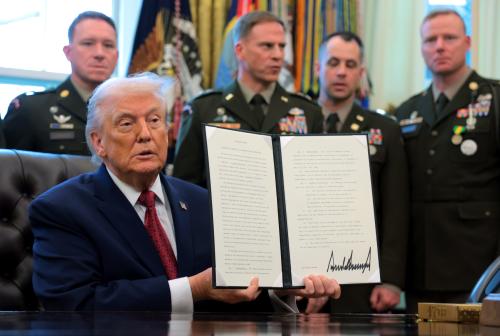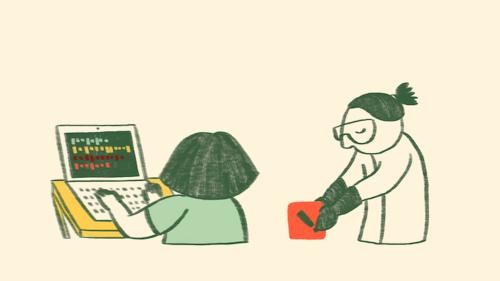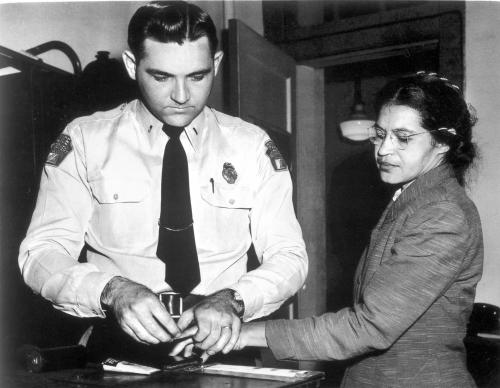A great deal has been written about the gender gap ever since it appeared in presidential elections in the 1980s. Since then, many elections have seen a clear difference in the way men and women vote—in general, women tend to vote more frequently for Democratic candidates and men for Republican candidates.
This year’s election puts the gender gap front and center for three reasons—one of the candidates could be the first woman president of the United States; the abortion issue has especially high salience for women and could increase their already high turnout; and the election in swing states is incredibly close.
The closeness of the election has created a daily torrent of speculation about which subgroups are leaning to which candidate. Often, as has been pointed out in these pages by my colleague Gabriel Sanchez, the subgroups in national polls are simply too small to have any statistical significance, making headlines swing wildly. One day, young people are deserting the Democrats; another day, Latinos are flocking to Republicans, and another day, Harris is losing Black men. It’s enough to make your head spin. The subgroup, however, that is large enough to avoid that problem is based on gender since nearly 100% of responders are cisgender, which means there are usually enough men and women in a standard poll to decrease the margin of error.1
Although pollsters use gender and other demographic information to “weight” their results—some use just census data and few use actual turnout data—the following analysis shows just how the interaction between polling trends and turnout works. Of course, we can’t predict turnout for 2024, but we can look at the most recent turnout by gender in presidential elections. If men and women turned out to vote in equal numbers, then we would expect that, for instance, if men preferred Trump by the same margins as women preferred Harris, their votes would cancel each other out, and, bottom line, the gender gap would not matter. But in fact, in recent elections, women have turned out more than men, thus affecting the gender gap. In the last presidential election, women accounted for 54.7% of the electorate and men accounted for 44%. And of course, there are simply more adult women than men in the population, especially among the elderly.2 In the seven swing states we looked at for this analysis, women composed a larger share of the electorate in 2020 than men, with one exception, Wisconsin, where, according to exit polls, 50% were men and 50% were women.
To better understand how the preference gender gap and the turnout gender gap interact, we apply the latest 2024 gender gap polling on presidential preference to the gender gap in 2020 turnout. Of course, as with everything based on polls and history, this could change. Presidential preferences among men and women might shift, and the composition of the 2024 electorate might look very different than the composition of the 2020 electorate. But this exercise illustrates the interactions between the two gender gaps—the one for presidential preference and the one for turnout.
Let’s start with the must-win state of Pennsylvania. In a recent Marist poll, women supported Harris by 55% to 43% for Trump, while men supported Harris by 44% and Trump by 54%3. In the 2020 presidential election in Pennsylvania, women accounted for more votes than men—they were 53% of the electorate, and men were 47%. There was a total of 6,915,283 ballots cast in Pennsylvania in 2020, most of which were cast by women, amounting to 3,665,100 votes. If the 2024 gender gap in turnout remains close to what it was in 2020, and the preference polls for 2024 remain the same, that would be 2,015,805 votes for Harris versus 1,575,993 votes for Trump among women and 1,430,081 votes for Harris among men and 1,755,099 votes for Trump among men. Given that nearly everyone in the electorate is a man or a woman, if the gender gap in presidential preference in 2024 was applied to 2020 turnout numbers, Harris should win Pennsylvania by 114,794 votes or 1.69%. In fact, in 2020, Biden won the state by 1.2% or 81,660 votes.
In North Carolina, we see a powerful example of the impact of the presidential preference gender gap combined with the turnout gender gap. There, according to a Marist poll, Harris is currently getting 54% of the women’s vote, and Trump is getting the exact same percentage (54%) of the men’s vote. If men and women voted in the same numbers, these votes would cancel each other out. But in 2020, women accounted for 56% of all voters. If the gender gap in presidential preference in 2024 was applied to the 2020 gender gap in turnout, Harris would win narrowly by 35,358 votes or 0.65%, putting the state into the blue column. In 2020, Trump won the state by 1.3% or 74,483 votes.
In states like Michigan, where the presidential gender gap and the turnout gender gap is large, the results can be impressive. In Michigan, a Marist poll finds 56% of the women currently favor Harris and 52% of men currently favor Trump. In 2020, the Michigan electorate was 54% women and 46% men. Applying the 2024 presidential preference to 2020 turnout results in a Harris win of 321,280 or 5.92%. In 2020, Biden won the state by three percent or 154,188 votes.
In Wisconsin, (according to a Marist poll) women currently favor Harris by 56%, and men favor Trump by 53%. Wisconsin is the rare swing state where men and women voted in equal numbers in 2020—turnout was 50% for men and the same for women. Thus, if both the 2024 gender gap in presidential preference and the 2020 gender gap in turnout remain the same, Harris should win the state by 2.54% or 82,720 votes. In 2020, Biden won Wisconsin by 0.63% or 20,682 votes.
In Nevada, 53% of women currently favor Harris and 52% of men currently favor Trump, according to a poll by Emerson.4 In 2020, 52% of the electorate was composed of women, and 48% of men. Emerson is the only poll cited in this piece that uses turnout data in their weighting thus the preference numbers in this poll probably already reflect women’s greater turnout. But if the women’s vote in Nevada in 2024 exceeds their turnout in 2020 it could help Harris if it falls below their turnout in 2020 it could help Trump.
Georgia and Arizona are the only swing states where the 2024 gender gap in presidential preference favors Trump, and in both states, the gender gap in turnout is not large enough to help Harris. In Georgia, a CBS poll found there seem to be more men planning to vote for Trump (56%) than women voting for Harris (53%)5. In Georgia, in 2020, women cast a large number of votes—2,799,150, or 56% of the total vote. Applying the 2024 gender gap numbers to the 2020 turnout numbers, Trump would win the state by 117,964 votes or 2.37%. In 2020, Biden had a very narrow victory in Georgia, winning it by 0.24% or 11,779 votes.
In Arizona, the current gender gap appears to favor Trump as well. Slightly more men favor Trump (53%) than women favor Harris (52%), according to a Marist poll. In 2020, women were 52% of voters and men were 48%. If these numbers hold in November, Trump would win the state by 25,996 or 0.77% of the vote. In Arizona, Biden had his narrowest win, winning the state by 0.31% with only 10,457 votes.
This exercise shows that if the composition of the electorate between men and women remains the same as it was in 2020, Harris could win Pennsylvania, Michigan, Wisconsin, and Nevada—all states Biden won in 2020. She could also win North Carolina (which Biden lost in 2020) but by a very narrow margin. Trump would win Arizona and Georgia, two states Biden won in 2020. This would result in a Harris win in the Electoral College.
Of course, the assumptions in this analysis could easily change next month. The abortion referendum in Arizona, for instance, has the potential to boost the women’s vote past what it was in 2020, and that could be good for Harris. What will not change is that the importance of the gender gap in presidential preference is highly dependent on the existence of a gender gap in turnout. The reality of both gender gaps has hit the Republican Party hard; candidates across the board are scrambling to soften or even repeal their former statements on abortion. And the release of a very strong pro-choice stance by former First Lady Melania Trump means that from the very top of the ticket down, the Republican Party understands that this is their biggest threat.
The bottom line is this—if the gender gap in presidential preference remains the same but men’s turnout increases dramatically relative to 2020, it will be good for Trump; if women’s turnout stays the same as in 2020, it could be a good year for Harris; if it increases, it could be a very good year for her.
-
Footnotes
- According to Merriam-Webster, cisgender (also styled as cisgendered and often shortened to cis) describes someone whose internal sense of gender corresponds with the sex the person was identified as having at birth.
- In 2022, 31.9 million women and 25.9 million men were 65 and older. That’s 123 women for every 100 men. Among people 85 and older, this ratio increased to 184 women for every 100 men.
- “The Marist Poll post stratifies and balances its data to reflect Census results for age, gender, income, race, and region.”
- “Data was weighted by statewide voter parameters, including gender, age, race/ethnicity, education (US Census), and voter registration (state secretary of state) and turnout data (exit polling).”
- “The sample was weighted according to gender, age, race, education and geographic region, based on U.S. Census data and voter files, as well as to past vote. The margin of error for registered voters is ±3.5 points.”
The Brookings Institution is committed to quality, independence, and impact.
We are supported by a diverse array of funders. In line with our values and policies, each Brookings publication represents the sole views of its author(s).








Commentary
How gender gaps could tip the presidential race in 2024
October 7, 2024